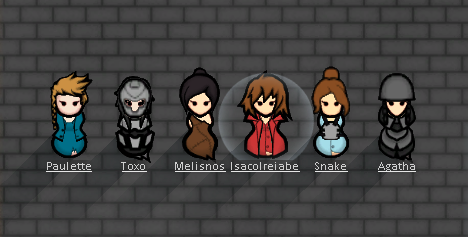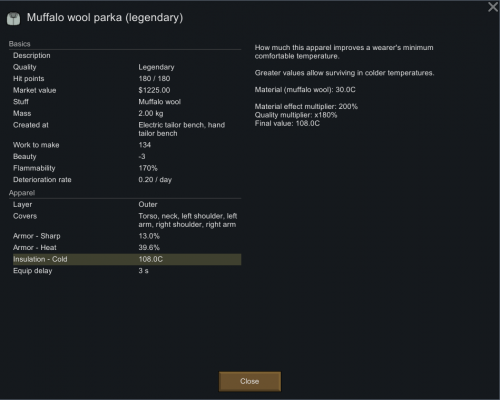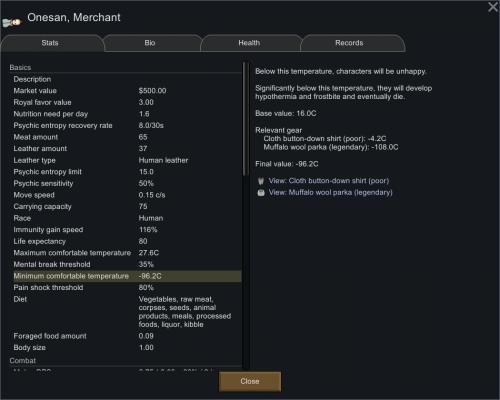Difference between revisions of "Apparel"
m (Corrected "Panthera Skin" to "Panthera fur") |
|||
| Line 353: | Line 353: | ||
|- | |- | ||
| − | | Panthera | + | | Panthera fur |
| Leathery | | Leathery | ||
| 93% | | 93% | ||
Revision as of 18:37, 30 November 2020
|
Apparel is worn by your colonists to protect them from extreme temperatures or from damage in combat. See a pawn's Gear tab to see what apparel they are wearing.
Clothing vs Armor
There are two main types of apparel, clothing and armor. Both clothing and armor use the same basic principles. They can be mixed and matched, as far as Clothing Layers allow.
Clothing usually:
- is made from light materials (fabrics and leathers);
- offers good insulation from extreme temperatures;
- offers lower protection from damage (with the right materials, clothing can be a worthwhile "light" armor).
Armor usually:
- is made from solid materials (metal);
- offers less insulation from extreme temperatures;
- offers good protection from damage;
- gives penalties to movement speed (from wearing the armor) and to carrying capacity (from the weight of the armor).
Protection
Protection mitigates damage to body parts. It can range anywhere from 0 to 100%. Metals tend to have higher values (up to 200%), however those values are drastically cut by the "Material Effect" modifier of the piece of clothing.
After the game has determined which body part was hit by an attack, the following math is applied:
- the Protection values for all worn items in that region are summed up
- the Penetration value of the weapon is subtracted, to get the modified Protection
- A percentile roll is made against the modified armor:
- If the roll is higher, the full damage is applied to the body part
- If the roll is lower, but still more than half - half damage is dealt. If it is a sharp attack, it also has the damage reduced to blunt trauma
- If the roll is half or less, no damage is done
That means an armor rating of 200% after penetration would result in de-facto damage immunity.
It is unclear how apparel loses hitpoints when blocking, partially blocking or not blocking damage.
Sharp Protection
Protection against claws, swords, spears and bullets. These attacks will cause cuts, stabs or gunshot wounds, which in turn are prone to cause bleeding. Even the lightest clothing material seems to offer some of this.
Blunt Protection
Protection against clubs, headbutts and strikes with ranged weapons at melee range.
Heat Protection
Protection against fire damage from natural fires and fire weapons such as Molotov cocktails. Not to be mistaken with Heat Insulation.
Insulation
Insulation offers protection against extreme temperatures like freezing cold and scorching heat. Every pawn and every animal has a natural range of acceptable temperatures. By default a naked human has a very narrow acceptable temperature range (16°C - 26°C), so you'll need to wear apparel to survive in the harsh environment of a rimworld.
Insulation from a single piece of apparel
Apparel can offer "Insulation - Cold", which protects from extremely cold temperatures, and "Insulation - Heat" which protects from extremely hot temperatures. The amount of insulation a piece of apparel offers is equal to:
Insulation = Material insulation * Apparel insulation_factor * Quality multiplier
- Material insulation: the textile used to create an article of clothing has a large impact on how much insulation a piece of apparel offers. For example, muffalo wool offers 30°C of insulation from cold, while birdskin only offers 10°C. See textiles for a full comparison.
- Apparel insulation factor: each type of apparel has an insulation factor associated with it. For example, a parkas have an insulation - cold factor of 2.0, so a normal muffalo wool parka offers 60°C of insulation from cold. See clothing for a full comparison.
- Quality multiplier: the quality of an item influences it's insulation as well. For example, legendary quality offers a 1.8x increase in insulation, so a legendary muffalo wool parka offers 108°C of insulation from cold. See quality for a full comparison.
Total insulation for a pawn
The total insulation for a pawn is the sum of the insulation from each piece of apparel. A pawn's minimum comfortable temperature is reduced by their total Insulation - Cold, while their maximum comfortable temperature is increased by their Insulation - Heat.
For example, consider a pawn wearing a legendary muffalo wool parka and a poor quality cloth button-down shirt. By default, humans have an acceptable temperature range of 16°C - 26°C. We can find the new temperature range by computing the insulation from the clothing, then adding to the base insulation:
Computing insulation from clothing
Parka cold insulation = muffalo wool cold insulation * parka cold insulation factor * legendary modifier = 30°C * 200% * 1.8 = 108°C
Parka heat insulation = muffalo wool heat insulation * parka heat insulation factor * legendary modifier = 12°C * 0% * 1.8 = 0°C
Shirt cold insulation = cloth cold insulation * shirt modifier * poor modifier = 18°C * 26% * 0.9 = 4.2°C
Shirt heat insulation = cloth heat insulation * shirt modifier * poor modifier = 18°C * 10% * 0.9 = 1.6°C
Adding to base insulation
Minimum acceptable temperature = default minimum acceptable temperature - parka cold insulation - shirt cold insulation = 16 - 108 - 4.2 = -96.2°C
Maximum acceptable temperature = default maximum acceptable temperature + parka heat insulation + shirt heat insulation = 26 + 0 + 1.6 = 27.6°C
So the new comfortable range is -96.2°C - 27.6°C
Flammability
How likely the item is to burst into flames while in storage. Often Heat Protection and this value are related. It is entirely dependent on the material.
It is unclear if it affects the chance for a Pawn to catch fire while standing in a burning tile.
Damaged apparel
Apparel suffers wear and tear when worn causing it to lose hit points over time. They also become damaged when the wearer is attacked, and the apparel absorbs some damage as armor.
A colonist wearing badly damaged apparel will have one of the following thoughts. These debuffs do not stack, only one is given based on the apparel with the worst condition.
| HP | Thought | Debuff |
|---|---|---|
| 20% - 50% | "Wearing worn-out apparel" | -3 |
| below 20% | "Wearing tattered apparel" | -5 |
Durability does not affect stats such as protection and insulation.
Quality Effects
| Quality | Armor Factor |
Insulation Factor |
Market Value | Max Market Value Gain | Deterioration Rate | Beauty |
|---|---|---|---|---|---|---|
| Awful | 0.6 | 0.8 | 0.5 | - | 2 | -0.1 |
| Poor | 0.8 | 0.9 | 0.75 | - | 1.5 | 0.5 |
| Normal | 1.0 | 1.0 | 1.0 | - | 1 | 1 |
| Good | 1.15 | 1.1 | 1.25 | 500 | 0.8 | 2 |
| Excellent | 1.3 | 1.2 | 1.5 | 1000 | 0.6 | 3 |
| Masterwork | 1.45 | 1.5 | 2.5 | 2000 | 0.3 | 5 |
| Legendary | 1.8 | 1.8 | 5 | 3000 | 0.1 | 8 |
Nudity
Male colonists are considered naked when their legs are not covered, while female colonists are considered naked when either their legs or chest are not covered. Most colonists will receive a -6 mood penalty from being naked, triggering an alert prompting the player to seek suitable clothing.
For Nudists the opposite is true - they receive a +20 mood bonus while naked and a -3 mood penalty while clothed.
Special Values
Clothing can have very specific secondary values. The more common ones are:
- Negative movement Speed. This is mostly seen with armor
- Bonus to social skills. This is a extremely common stat for any form of headwear that is not armor
- Pain Threshold. Specific to Tribal clothing, this increases when a character will collapses from damage
Tainted Apparel
Clothing stripped from corpses is considered tainted apparel and is noted with a T. Colonists wearing tainted apparel gain a persistent mood debuff as long as they're wearing it- colonists with Bloodlust do not seem to mind, however.
| Number of items | Debuff |
|---|---|
| 1 | -3 |
| 2 | -5 |
| 3 | -7 |
| 4+ | -8 |
Disposal is usually the only option as traders do not buy them (as of 0.19).
Disposal
Apparel can be destroyed using a crematorium or a campfire. Simply create a "Burn apparel" bill, and be sure to uncheck anything you want to keep.
Materials
A number of Materials is available for Clothing and Armor. Not every piece supports every material and a lot of the protective power of armor and insulation of clothing actually comes from the used material, rather than something unique to the item.
Armor Materials
These materials are primarily used for armor. It includes any metal and in rare cases, even wood or stone might be supported.
| Name | Stuff Category | Sharp | Blunt | Heat | Cold Insulation | Heat Insulation | Item HP | Market Value | Commonality | Flammability |
|---|---|---|---|---|---|---|---|---|---|---|
| Silver | Metallic | 72% | 36% | 36% | 3 | 0 | 0.7 | 1 | 100 | 0.4 |
| Gold | Metallic | 72% | 36% | 36% | 3 | 0 | 0.6 | 10 | 0.02 | 0.4 |
| Steel | Metallic | 90% | 45% | 72% | 3 | 0 | 1 | 1.9 | 1.0 | 0.4 |
| Plasteel | Metallic | 126% | 63% | 108% | 3 | 0 | 2.8 | 9 | 0.05 | 0.2 |
| Wood | Woody | 54% | 54% | 90% | 8 | 4 | 0.65 | 1.2 | 1 | 1 |
| Uranium | Metallic | 108% | 54% | 90% | 3 | 0 | 2.5 | 6 | 0.05 | 0 |
| Jade | Stony | 90% | 45% | 54% | 3 | 0 | 0.5 | 5 | 0.05 | 0 |
Clothing Materials
All variants of Fabric and Leathers.
| Name | Stuff Category | Sharp | Blunt | Heat | Cold Insulation | Heat Insulation | Item HP Multiplier | Market Value | Commonality | Flammability |
|---|---|---|---|---|---|---|---|---|---|---|
| LeatherBase | Leathery | 81% | 24% | 150% | 16 | 16 | 1.3 | 2.1 | 0.025 | 1 |
| Plain Leather | Leathery | 81% | 24% | 150% | 16 | 16 | 1.3 | 2.1 | 0.020 | 1 |
| Dog Leather | Leathery | 81% | 24% | 150% | 14 | 16 | 1.3 | 2.0 | 0.075 | 1 |
| Wolfskin | Leathery | 102% | 24% | 150% | 24 | 16 | 1.3 | 3.0 | 0.075 | 1 |
| Panthera fur | Leathery | 93% | 24% | 150% | 16 | 24 | 1.3 | 3.0 | 0.025 | 1 |
| Camelhide | Leathery | 81% | 24% | 150% | 16 | 24 | 1.3 | 2.3 | 0.05 | 1 |
| Bluefur | Leathery | 81% | 24% | 150% | 20 | 16 | 1.3 | 2.3 | 0.025 | 1 |
| Bearskin | Leathery | 112% | 24% | 150% | 20 | 20 | 1.3 | 3.4 | 0.05 | 1 |
| Human Leather | Leathery | 64% | 24% | 150% | 12 | 12 | 1.3 | 4.2 | 0.025 | 1 |
| Pigskin | Leathery | 64% | 24% | 150% | 12 | 12 | 1.3 | 1.9 | 0.05 | 1 |
| Lightleather | Leathery | 54% | 14% | 150% | 12 | 12 | 1.3 | 1.9 | 0.25 | 1 |
| Birdskin | Leathery | 67% | 14% | 150% | 10 | 10 | 1.3 | 1.8 | 0.025 | 1 |
| Chinchilla Fur | Leathery | 67% | 14% | 150% | 30 | 16 | 1.3 | 6.5 | 0.025 | 1 |
| Foxfur | Leathery | 81% | 21% | 150% | 20 | 16 | 1.3 | 3.5 | 0.075 | 1 |
| Lizardskin | Leathery | 81% | 27% | 150% | 12 | 12 | 1.3 | 2.1 | 0.075 | 1 |
| Elephant Leather | Leathery | 112% | 24% | 150% | 14 | 12 | 1.3 | 3.0 | 0.025 | 1.5 |
| Heavy Fur | Leathery | 124% | 24% | 150% | 30 | 14 | 1.3 | 3.3 | 0.025 | 1.5 |
| Rhinoceros Leather | Leathery | 129% | 24% | 150% | 14 | 14 | 1.3 | 4.2 | 0.025 | 1.5 |
| Thrumbo Fur | Leathery | 208% | 36% | 150% | 34 | 22 | 1.3 | 14 | 0.0025 | 2.0 |
| Patchleather | Leathery | 45% | 19% | 90% | 9 | 9 | 1.3 | 1.5 | 0.075 | 1 |
| Cloth | Fabric | 36% | 0% | 18% | 18 | 18 | ? | 1.5 | 1.4 | 1.2 |
| Synthread | Fabric | 63% | 0% | 72% | 22 | 22 | 1.3 | 4 | 0.15 | 0.7 |
| Devilstrand | Fabric | 140% | 36% | 300% | 20 | 24 | 1.3 | 5.5 | 0.2 | 0.4 |
| Hyperweave | Fabric | 200% | 54% | 288% | 26 | 26 | 2.4 | 9 | 0.1 | 0.4 |
| Woolbase | Fabric | 36% | 0% | 36% | Cold Insulation | Heat Insulation | ? | 2.7 | 0.12 | ? |
| Megasloth Wool | Fabric | 36% | 0% | 36% | 30 | 12 | ? | 2.7 | 0.12 | ? |
| Muffalo Wool | Fabric | 36% | 0% | 36% | 30 | 12 | ? | 2.7 | 0.12 | ? |
| Camelhair | Fabric | 36% | 0% | 36% | 18 | 26 | ? | 2.7 | 0.12 | ? |
| Alpaca Wool | Fabric | 36% | 0% | 36% | 28 | 16 | ? | 2.7 | 0.12 | ? |
Version history
- 0.8.657 - Apparel insulation introduced with temperature system.
- 0.9.722 - Apparel becomes damaged when owner dies from violence, takes the damage it absorbs as armor and wears out over very long periods of use. Tattered apparel thought added.


